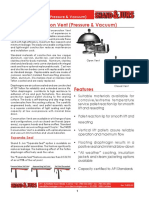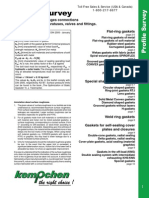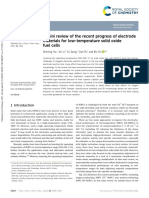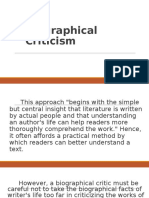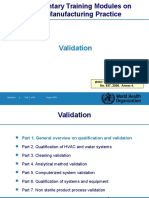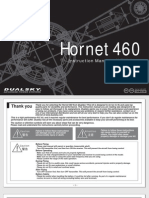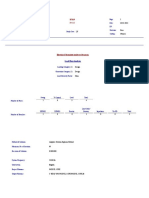Alfa Laval Alfa Laval Diabon Product Leaflet en
Alfa Laval Alfa Laval Diabon Product Leaflet en
Uploaded by
Ayelen VillarinoCopyright:
Available Formats
Alfa Laval Alfa Laval Diabon Product Leaflet en
Alfa Laval Alfa Laval Diabon Product Leaflet en
Uploaded by
Ayelen VillarinoOriginal Description:
Original Title
Copyright
Available Formats
Share this document
Did you find this document useful?
Is this content inappropriate?
Copyright:
Available Formats
Alfa Laval Alfa Laval Diabon Product Leaflet en
Alfa Laval Alfa Laval Diabon Product Leaflet en
Uploaded by
Ayelen VillarinoCopyright:
Available Formats
Alfa Laval DIABON®
Graphite plate heat exchanger
Applications
Heaters, coolers, interchangers, condensers and evaporators
for corrosive media, especially in the treatment of:
-Hydrochloric acid (HCl)
-Sulfuric acid (H2SO4)
-Hydrofluoric acid (HF)
-Mixed Acids (HNO3/HF)
-Phosphoric acid (H3PO4/P2O5)
-Other organic and inorganic media
Standard design
The graphite plate heat exchanger consists of a pack of
corrugated graphite plates with portholes for the passage of
the two fluids between which heat transfer will take place.
The plate pack is assembled between a carbon steel fixed
frame plate and movable pressure plate and compressed by
tightening bolts. The difference in coefficients of expansion of
carbon steel and graphite is compensated for by means of
helical springs.
The plates are fitted with a film type PTFE gasket of 0,2 mm
thickness after tightening, which seals the interplate channel Plate types: S1, M10-G, S10, S15.
and directs the fluids into alternate channels. The number
of plates is determined by the flow rate, pressure drop and Frame types: One standard frame available that can be
temperature program. The plate corrugations promote fluid modified to higher design pressures.
turbulence and minimize fouling.
Working principle
The frame plate and pressure plates are suspended from an Channels are formed between the plates and the corner ports
upper carrying bar and located by a lower guiding bar, both of are arranged so that the two media flow through alternate
which are fixed to a support column. Connections are located channels. The heat is transferred through the plate between
in the frame plate or, if either or both fluids make more than a the channels, and complete counter current flow is created for
single pass within the unit, in the frame and pressure plates. the highest possible efficiency. The corrugation of the plates
provides the passage between the plates, supports each
The frame and pressure plates are protected from the plate against the adjacent one and enhances the turbulence,
corrosive media by means of a PTFE lining. resulting in efficient heat transfer.
Typical capacities Standard materials
Max flow rate of 250 m3/h, depending on media, permitted Plates: F100, NS1/NS2
pressure drop and temperature program.
F100 NS1/NS2
DIABON® F100 plates are suitable for operations NS1 and NS2 grade plates are preferred for 2 phase
where fouling can be a problem as well as for oxidising applications and/or duties with higher variations in
environments. temperature.
The DIABON® F100 plates are pressure moulded with a The NS1 and NS2 plate pattern is machined from blocks of
herringbone plate pattern on both sides which gives rise to resin impregnated material. The plates are flat on one side
very efficient turbulence. Erosion risk is minimized due to a and have a fin-plate pattern on the side facing the pressure
hard plate surface. The PVDF encapsulating of the graphite plate. The plate pattern has very few contact points which
grains yields plates with a very smooth, non-porous and makes the plates more suitable for fluids containing fibres. The
anti-adhesive surface and provides more resistance against resin impregnated graphite in these plates is less sensitive to
oxidising media. thermal fatigue and can handle high temperature differences.
These plates are not suitable for oxidising media.
F100 NS1 (NS2)
Plate material Plate material
Graphite + PVDF Resin impregnated graphite
Graphite encapsulated in a fluoroplastic binder Same material as used in S&T and block heat exchangers
Pressure-moulded Machined plates
Herringbone pattern Plate fin type
Smooth surface "If touched - you’re black"
Good against erosion
Anti fouling surface
Tdes = 140 ºC Tdes = 200 ºC
Ptest 9,1 barg, Pdes = approximately 7 barg Ptest 9,1 barg, Pdes = approximately 7 barg
(Ptest = 10,4 barg, special) (Ptest = 10,4 barg, special)
Application Application
Better with oxidizing media No nitric acid
PVDF not good with DIABON® NS2 better than NS1
- amines & NaOH - organic chem. (case to case basis)
- organic chem. (case to case basis)
S1, M10-G, S10 S1-N, M10-GN, S10-N, S15-N
- Thermal fatigue + Steam heating
- Lower max. temperature + Higher max. temperature
Plate Gaskets: PTFE, plastic
Frame plate: Carbon Steel, P265GH or SA516 Gr. 60
Guide bars: 1.4301 (SS grade)
Compression springs: 51CrV4
Nozzels: Lining of frame/pressure plates and connections:
PTFE (Licuflon)
Technical data
DIABON® graphite plate heat exchanger S1 DIABON® graphite plate heat exchanger M10-G
DIABON® graphite plate heat exchanger S10 DIABON® graphite plate heat exchanger S15
Plates
DIABON® graphite plate DIABON® graphite plate
heat exchanger S1 heat exchanger M10-G
Property Unit DIABON® F100 DIABON® NS1 (NS2) DIABON® F100 DIABON® NS1 (NS2)
Corrugation pattern turbulent flow free flow turbulent flow free flow
(high and low theta)
Typical heat transition coefficients W/K-m2 2000 4500 2200 4500
Exchange area per plate m2 0.05 0.03 0.25 0.18
Max. no. of plates per frame 80 64 160 100
Plate thickness mm 8 10 6.5 10
Liquid capacity l 0.18 0.12 0.7 0.6
Weight of a plate kg 0.75 0.95 2.7 4.2
Plate Seals SIGRAFLEX® graphite SIGRAFLEX® graphite PTFE, plastic PTFE, plastic
Frame
DIABON® graphite plate DIABON® graphite plate
heat exchanger S1 heat exchanger M10-G
Property Unit DIABON® F100 DIABON® NS1 (NS2) DIABON® F100 DIABON® NS1 (NS2)
Width x height mm 230 x 620 512 x 1170
Length L mm 350/450/550/650/750/850 912/1162/1512/1762
Max. no. of plates for length L 18/30/43/55/68/80 14/24/34/44/54/64 32/70/125/160 20/45/80/100
Weight excl. DIABON® graphite kg 105-125 610-650
Connections – frame plate S1-S4 DN 100 (DN 80) DIN EN 1092-1 PN16 DN 25 DIN EN 1092-1 PN16
or pressure plate T1-T4 or DN 1” ANSI 150 lbs or DN 4” (DN 3”) ANSI 150 lbs
Test pressure with water bar standard: 9.1/special design: 10.4 standard: 9.1/special design: 10.4
Design temperature o
C 140 200 140 200
Plates
DIABON® graphite plate DIABON® graphite plate
heat exchanger S10 heat exchanger S15
Property Unit DIABON® F100 DIABON® NS1 (NS2) DIABON® NS1 (NS2)
Corrugation pattern turbulent flow free flow free flow
Typical heat transition coefficients W/K-m2 2000 4000 4000
Exchange area per plate m 2
0.4 0.30 0.63
Max. no. of plates per frame 130 96 90
Plate thickness mm 8 10 10
Liquid capacity l 1.5 1.4 2.6
Weight of a plate kg 6.1 7.1 15.3
Plate seals PTFE, plastic PTFE, plastic PTFE, plastic
Frame
DIABON® graphite plate DIABON® graphite plate
heat exchanger S10 heat exchanger S15
Property Unit DIABON® F100 DIABON® NS1 (NS2) DIABON® NS1 (NS2)
Width x height mm 570 x 1473 570 x 1473 675 x 2245
Length L mm 912/1162/1512/1762 912/1162/1512/1762 942/1192/1542/1792
Max. no. of plates for length L 25/55/100/130 16/40/72/96 16/32/66/90
Weight excl. DIABON® graphite kg 900-940 900-940 1500-2300
Connections – frame plate S1-S4 DN 100 DIN EN 1092-1 PN16 DN 150 DIN EN1092-1 PN16
or pressure plate T1-T4 or DN 4” ANSI 150 lbs or DN 6” ANSI 150 lbs
Test pressure with water bar standard: 9.1/special design: 10.4 standard: 9.1/special design: 10.4
Design temperature C
o
140 200 200
Materials
Frame and pressure plates P265GH or SA516 Gr. 60 DIABON® graphite plate heat exchangers are manufactured
Tie rods and stud bolts 21CrMoV57 alt. SA193 Gr. B7 in accordance with Pressure Equipment Directive 97/23/EC,
Nuts 25CrMo4V alt. SA194 2H categories I to III, module B (EC type testing of series-
Compression springs 51CrV4
produced pressure vessels) and C1 (conformity to design).
Guide bars 1.4301 (stainless steel grade)
The design calculations for our plate heat exchangers are
Lining of frame/pressure plates
based on specifications AD 2000-Regelwerk.
and connections PTFE (LICUFLON)
Painting 2-component epoxy paint
1 priming coat of Hempadur 15570, 100 μm
1 intermediate coat of Hempadur 15570, 100 μm
1 top coat of Hempathane 55210, 60 μm
shade: similar to RAL 5002
PPI00556EN 1304 Alfa Laval reserves the right to change specifications without prior notification.
How to contact Alfa Laval
Up-to-date Alfa Laval contact
details for all countries are
always available on our website
at www.alfalaval.com.
You might also like
- Seamless steel tubes for structural purposes (结构用无缝钢管) : National Standard of the People's Republic of ChinaDocument25 pagesSeamless steel tubes for structural purposes (结构用无缝钢管) : National Standard of the People's Republic of ChinaJignesh Suthar100% (1)
- Plate Heat ExchangerDocument4 pagesPlate Heat Exchangeronezien100% (1)
- SGL Technical Competence Sheet DIABON BHX CK NCKDocument2 pagesSGL Technical Competence Sheet DIABON BHX CK NCKNoo SokiNo ratings yet
- SGL Information Sheet PT DIABON Graphite THX enDocument2 pagesSGL Information Sheet PT DIABON Graphite THX enTushar LateNo ratings yet
- Brochure Cathelain GBDocument28 pagesBrochure Cathelain GBFg FgNo ratings yet
- Moisture and Fire Resistant Gypsum Board (WRFR)Document3 pagesMoisture and Fire Resistant Gypsum Board (WRFR)burakNo ratings yet
- DIABON® Shell & Tubes Heat ExchangerDocument0 pagesDIABON® Shell & Tubes Heat ExchangerlucianduNo ratings yet
- Moisture and Fire Resistant Gypsum Board-WRFR-2020Document3 pagesMoisture and Fire Resistant Gypsum Board-WRFR-2020ogtNo ratings yet
- Gaskets - Graphite PDFDocument4 pagesGaskets - Graphite PDFSH1961No ratings yet
- Fire Resistant Gypsum Board (FRDF)Document3 pagesFire Resistant Gypsum Board (FRDF)KRISSELLE TAYCONo ratings yet
- MDS RHEINZINK-prePATINA Blue-Grey 11 - 2015 - DE - enDocument4 pagesMDS RHEINZINK-prePATINA Blue-Grey 11 - 2015 - DE - enPetre Cristian AlexandruNo ratings yet
- Heat Exchanger Gaskets 1 PDFDocument2 pagesHeat Exchanger Gaskets 1 PDFMuhammad Aftab AhmedNo ratings yet
- Heat Exchanger Gaskets 1 PDFDocument2 pagesHeat Exchanger Gaskets 1 PDFMuhammad Aftab AhmedNo ratings yet
- Blockwaermeaustauscher eDocument16 pagesBlockwaermeaustauscher eAhmed Emad AhmedNo ratings yet
- Away Fire - Resistant - Gypsum - Board-FR-2019 PDFDocument3 pagesAway Fire - Resistant - Gypsum - Board-FR-2019 PDFMatijaNo ratings yet
- Applications: DCS200 SeriesDocument3 pagesApplications: DCS200 SeriesAgus YulfizarNo ratings yet
- Productsheet Flameshield Antislip ENDocument1 pageProductsheet Flameshield Antislip ENfelghazi87No ratings yet
- PIN BEARING CatalogueDocument52 pagesPIN BEARING CatalogueMileNo ratings yet
- SpecsDocument13 pagesSpecsashharsyedmgsNo ratings yet
- Productsheet C-Dur Antislip ENDocument1 pageProductsheet C-Dur Antislip ENfelghazi87No ratings yet
- TL SarnafilTMetalSheetDocument4 pagesTL SarnafilTMetalSheetMauricio SuarezNo ratings yet
- Productsheet Flameshield Deluxe ENDocument1 pageProductsheet Flameshield Deluxe ENfelghazi87No ratings yet
- Conservation Vent (Pressure & Vacuum)Document8 pagesConservation Vent (Pressure & Vacuum)SudhirNo ratings yet
- Control Valve Selection and SizingDocument16 pagesControl Valve Selection and SizingSnehashis BoseNo ratings yet
- Breather Valve 94020-3HDocument8 pagesBreather Valve 94020-3Hbuzz cmkyNo ratings yet
- Technical Bulletin: ArgusDocument11 pagesTechnical Bulletin: ArgusTerry wei shengNo ratings yet
- 1 Heat Exchanger VDFDocument26 pages1 Heat Exchanger VDFPablo TorresNo ratings yet
- JC Gasket CranfoilDocument2 pagesJC Gasket CranfoilMachineryengNo ratings yet
- Technical Bulletin: NAF Setball SF Ball Sector ValvesDocument16 pagesTechnical Bulletin: NAF Setball SF Ball Sector ValvesFahmi HaidiNo ratings yet
- 16 StaticgasketsDocument10 pages16 StaticgasketsRobinReyndersNo ratings yet
- Part No. Description Page No.: Packing (Section IX)Document32 pagesPart No. Description Page No.: Packing (Section IX)Vilius BukysNo ratings yet
- Vogel LS LC LCP BrochureDocument12 pagesVogel LS LC LCP BrochureDwi Sulistyo BudiNo ratings yet
- Ic2024 - 17 - 1Document26 pagesIc2024 - 17 - 1sk tripathiNo ratings yet
- PHE SelectionsDocument67 pagesPHE SelectionsSelva Kumar Selva KumarNo ratings yet
- Turmotemp II 400 Rs 00 Ti enDocument1 pageTurmotemp II 400 Rs 00 Ti enKoushar MechanictcNo ratings yet
- Design Data Sheet For Air ReceiverDocument3 pagesDesign Data Sheet For Air ReceivergksakthiNo ratings yet
- SpecificationDocument1 pageSpecificationmodylolo2340No ratings yet
- 2016 Chemistry Solutions GBDocument8 pages2016 Chemistry Solutions GBWillie Cheong Han YangNo ratings yet
- Liqui Cel EXF Series 10x28 DatasheetDocument2 pagesLiqui Cel EXF Series 10x28 Datasheetwongpengchiong7205No ratings yet
- Thermowell With Flange Model TW10: ApplicationsDocument6 pagesThermowell With Flange Model TW10: ApplicationsEr Mangesh MohiteNo ratings yet
- Profile SurveyDocument10 pagesProfile Surveygalici2002No ratings yet
- Productsheet C-Dur Deluxe ENDocument1 pageProductsheet C-Dur Deluxe ENfelghazi87No ratings yet
- General Presentationfor - SONDEXDocument128 pagesGeneral Presentationfor - SONDEXselton.scientificNo ratings yet
- SGL Carbon - Graphite HeDocument28 pagesSGL Carbon - Graphite HevenkateaNo ratings yet
- DFS (GS 06p01y01-E-E - 008)Document30 pagesDFS (GS 06p01y01-E-E - 008)tetioNo ratings yet
- Flexitallic Flexpro Brochure 11-30-2017Document8 pagesFlexitallic Flexpro Brochure 11-30-2017Imthiyaz HNo ratings yet
- Merkel - Guides-Guide Strip FBDocument3 pagesMerkel - Guides-Guide Strip FBÖzgür GürkanNo ratings yet
- Iaphragm Alves: Broad Material AvailabilityDocument6 pagesIaphragm Alves: Broad Material AvailabilityrodgerNo ratings yet
- Structure PackingDocument8 pagesStructure PackingKalpesh MoreNo ratings yet
- Productsheet C-Dur Supreme Deluxe ENDocument1 pageProductsheet C-Dur Supreme Deluxe ENfelghazi87No ratings yet
- Coating Materials For Metal-Seated Ball Valves: Ensuring Tight Shut-Off and Extreme Reliability in ServiceDocument6 pagesCoating Materials For Metal-Seated Ball Valves: Ensuring Tight Shut-Off and Extreme Reliability in Serviceharish mohammedNo ratings yet
- GrafTech DOE Bipolar Plate Presentation February 142017 FinalDocument19 pagesGrafTech DOE Bipolar Plate Presentation February 142017 FinalArielDanieliNo ratings yet
- Mds Rheinzink-Artcolor Skygrey 04 2018 de enDocument3 pagesMds Rheinzink-Artcolor Skygrey 04 2018 de encarlosNo ratings yet
- RhinoboardDocument16 pagesRhinoboardraditanka aobakweNo ratings yet
- Formplatte k711f de 0111 EngDocument2 pagesFormplatte k711f de 0111 EngAlexandru IonescuNo ratings yet
- CMOS Technology and Passive DevicesDocument23 pagesCMOS Technology and Passive DeviceskimjinNo ratings yet
- Industrial Diaphragm Valves: SaundersDocument14 pagesIndustrial Diaphragm Valves: SaundersscribdkhatnNo ratings yet
- WPCA Duke 2008 SCR Management Nate WhiteDocument41 pagesWPCA Duke 2008 SCR Management Nate WhiteSteve WanNo ratings yet
- 2-Part PUR Highly Elastic, Crack-Bridging Coating: Product DescriptionDocument7 pages2-Part PUR Highly Elastic, Crack-Bridging Coating: Product Descriptionbeck.26No ratings yet
- d2cp05133h PDFDocument16 pagesd2cp05133h PDF魏一琛No ratings yet
- Pierre Lacoste-Bouchet A, Guy Desch Nes B, Edward Ghali C (1998)Document15 pagesPierre Lacoste-Bouchet A, Guy Desch Nes B, Edward Ghali C (1998)ratnaNo ratings yet
- INTERSUBJECTIVITYDocument30 pagesINTERSUBJECTIVITYmarielle astovezaNo ratings yet
- BiographicalDocument13 pagesBiographicalChrizzieTaasanNo ratings yet
- Understanding The Cost of Structural Steelwork Part 2 Design Development and DetailingDocument4 pagesUnderstanding The Cost of Structural Steelwork Part 2 Design Development and DetailingkhoohuikiangNo ratings yet
- PUB WRN - Advisory Notes For Works Within Sewer Protection ZoneDocument15 pagesPUB WRN - Advisory Notes For Works Within Sewer Protection ZoneGeorge VNo ratings yet
- Elnet CommDocument82 pagesElnet CommNicolas A. RomanNo ratings yet
- NICABM InfoG StructuralDissociationModelDocument2 pagesNICABM InfoG StructuralDissociationModelssjeliasNo ratings yet
- Validation Part1Document39 pagesValidation Part1Andy Rojas100% (2)
- Project Report PDFDocument54 pagesProject Report PDFAnonymous seytiZsQEc100% (1)
- Hornet 460 ManualDocument24 pagesHornet 460 ManualGildaEnxerNo ratings yet
- S03 Drill FeedDocument24 pagesS03 Drill FeedSales AydinkayaNo ratings yet
- Summer Training New 1Document43 pagesSummer Training New 1ROHIT KUMAR100% (2)
- De Lange Ketteridge LTDDocument8 pagesDe Lange Ketteridge LTDjasminetsoNo ratings yet
- Enclosure No 05 Presentation Portfolio Assessment Scoring SheetDocument1 pageEnclosure No 05 Presentation Portfolio Assessment Scoring SheetArnel NaritoNo ratings yet
- Tutorial 2G Step Checking ProblemDocument78 pagesTutorial 2G Step Checking ProblemNiapionUmineInaZainNo ratings yet
- Cosmetic Product Usage and Self Confidence Among Humss StudentsDocument7 pagesCosmetic Product Usage and Self Confidence Among Humss StudentsCastañares Denolan Angel Chieren100% (1)
- Nga Compliant 2021Document7 pagesNga Compliant 2021Belle ObradorNo ratings yet
- Presentation On Expansive Soil Given by Farid and ChattaDocument33 pagesPresentation On Expansive Soil Given by Farid and ChattaMuhammad Farooq Zia62% (13)
- Sound Eklin Efilm Tools Quick Reference Guide 092311Document1 pageSound Eklin Efilm Tools Quick Reference Guide 092311Jose QuiscaNo ratings yet
- Julia Landon College Preparatory and Leadership Development School Curriculum Paper 2009-2010 Seventh Grade Pre-Algebra Ms. HamlowDocument3 pagesJulia Landon College Preparatory and Leadership Development School Curriculum Paper 2009-2010 Seventh Grade Pre-Algebra Ms. HamlowsdhamlowNo ratings yet
- CHAPTER.1 of Minor ProjectDocument38 pagesCHAPTER.1 of Minor ProjectAadil AhmadNo ratings yet
- Blue Print For Question Paper PatternDocument4 pagesBlue Print For Question Paper PatternBasava VillanNo ratings yet
- FC - Reflection PaperDocument4 pagesFC - Reflection Paperapi-544865081No ratings yet
- Summer Research Project (SRP) Guidelines For PGDM Batch 2019-21Document21 pagesSummer Research Project (SRP) Guidelines For PGDM Batch 2019-21Satish rajNo ratings yet
- Marketing Research: MKTG Lamb, Hair, and McdanielDocument46 pagesMarketing Research: MKTG Lamb, Hair, and McdanielscribbbbsNo ratings yet
- Surgery Prepladder Cam 2Document263 pagesSurgery Prepladder Cam 2Femoral boiiNo ratings yet
- MODUL 3 SPK - LF1S - CompleteDocument12 pagesMODUL 3 SPK - LF1S - CompleteKhovivatul qolbyNo ratings yet
- FBRCDocument26 pagesFBRCLucas ScioscioliNo ratings yet
























